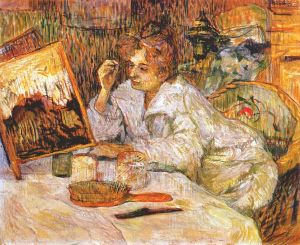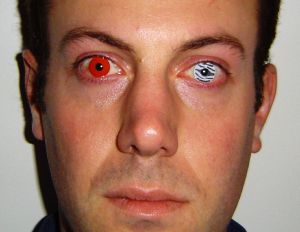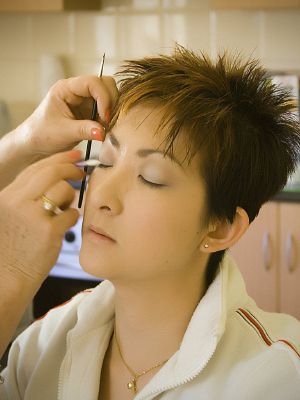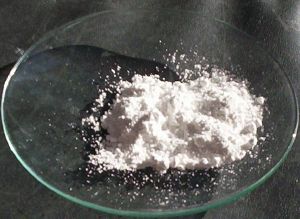|
|
| Line 3: |
Line 3: |
| | [[Image:Cosmetics.JPG|thumb|250px|Assorted cosmetics and tools.]] | | [[Image:Cosmetics.JPG|thumb|250px|Assorted cosmetics and tools.]] |
| | | | |
| − | '''Cosmetics''' are substances used to enhance or protect the appearance or odor of the human body. Cosmetics include skin-care creams, lotions, powders, perfumes, lipsticks, fingernail and toenail polishes, eye and facial makeup, permanent waves, hair colors, hair sprays and gels, deodorants, baby products, bath oils, bubble baths, bath salts, butters and many other types of products. Their use is widespread, especially among women in Western countries. A subset of cosmetics is called "make-up," which refers primarily to colored products intended to alter the user’s appearance. | + | '''Cosmetics''' are substances used to enhance or protect the appearance or odor of the human body. They include skin-care creams, lotions, powders, perfumes, lipsticks, fingernail and toenail polishes, eye and facial makeup, permanent waves, hair colors, hair sprays and gels, deodorants, baby products, bath oils, bubble baths, bath salts, butters and many other types of products. Their use is widespread, especially among women in Western countries. A subset of cosmetics is called "make-up," which refers primarily to colored products intended to alter the user’s appearance. |
| | | | |
| − | The U.S. [[Food and Drug Administration]] (FDA), which regulates cosmetics in the United States,<ref name=USHealthandHuman>Reed, Sandra I. 2004. [http://www.4woman.gov/faq/cosmetics.htm Cosmetics and Your Health]. US Department of Health and Human Services. Retrieved September 11, 2007.</ref> defines cosmetics as: "intended to be applied to the human body for cleansing, beautifying, promoting attractiveness, or altering the appearance without affecting the body's structure or functions." This broad definition includes, as well, any material intended for use as a component of a cosmetic product. The FDA specifically excludes [[soap]] from this particular category.<ref>Lewis, Carol. 2000. [http://www.fda.gov/fdac/features/1998/398_cosm.html Clearing up Cosmetic Confusion]. FDA. Retrieved September 11, 2007.</ref> | + | The U.S. [[Food and Drug Administration]] (FDA), which regulates cosmetics in the United States,<ref name=USHealthandHuman>Reed, Sandra I. 2004. [http://www.4woman.gov/faq/cosmetics.htm Cosmetics and Your Health]. US Department of Health and Human Services. Retrieved September 11, 2007.</ref> defines cosmetics as products "intended to be applied to the human body for cleansing, beautifying, promoting attractiveness, or altering the appearance without affecting the body's structure or functions." This broad definition includes any material intended for use as a component of a cosmetic product. The FDA specifically excludes [[soap]] from this particular category.<ref>Lewis, Carol. 2000. [http://www.fda.gov/fdac/features/1998/398_cosm.html Clearing up Cosmetic Confusion]. FDA. Retrieved September 11, 2007.</ref> |
| | | | |
| | ==History== | | ==History== |
| | [[Image:Lautrec woman at her toilette 1889.jpg|thumb|right|An 1889 [[Henri de Toulouse-Lautrec]] painting of a woman applying cosmetics to her face.]] | | [[Image:Lautrec woman at her toilette 1889.jpg|thumb|right|An 1889 [[Henri de Toulouse-Lautrec]] painting of a woman applying cosmetics to her face.]] |
| | | | |
| − | The '''history of cosmetics''' spans at least 6000 years of human history, and almost every society on earth. | + | The '''history of cosmetics''' spans at least 6,000 years of human history, and almost every society on earth. In the Western world, the use of cosmetics became prominent in the Middle Ages, typically among members of the upper classes. |
| | | | |
| − | The first archaeological evidence of cosmetics usage is found in [[Ancient Egypt]] around 4000 B.C.E. The [[Ancient Greek]]s and [[Ancient Rome|Romans]] also used cosmetics. The Romans and [[Ancient Egyptians]] used cosmetics containing [[mercury (element)|mercury]] and often [[lead]].<ref name=CEN>Johnson, Rita. 1999. [http://pubs.acs.org/cen/whatstuff/stuff/7728scit2.html What's that Stuff?] Chemical & Engineering News. Retrieved September 11, 2007.</ref> The Biblical book of [[Esther]] describes various beauty treatments.
| + | Cosmetic use was frowned upon at some points in history. For example, in the nineteenth century, make-up was used primarily by [[prostitute]]s, and Queen Victoria publicly declared makeup improper, vulgar, and acceptable for use by actors only.<ref name=CEN/> Adolf Hitler told women that face painting was for clowns and not for the women of the Master Race. |
| | | | |
| − | In the western world, the advent of cosmetics was in the middle ages, although typically restricted to use within the upper classes.
| + | By the middle of the twentieth century, cosmetics were in widespread use in nearly all societies around the world. |
| | | | |
| − | Cosmetic use was frowned upon at some points in history. For example, in the nineteenth century, make-up was used primarily by [[prostitute]]s, and Queen Victoria publicly declared makeup improper, vulgar, and acceptable for use by actors, only.<ref name=CEN/> Adolf Hitler told women that face painting was for clowns and not for the women of the Master Race.
| + | === Ancient Egypt, Greece, and Rome === |
| | + | [[Image:Hippo tusk makeup.jpg|right|thumb|Egyptian cosmetics box from the [[Bronze Age]].]] |
| | | | |
| − | By the middle of the twentieth century, cosmetics were in widespread use in nearly all societies around the world.
| + | The first archaeological evidence of cosmetics usage is found in [[Ancient Egypt]] around 4000 B.C.E. The [[Ancient Greek]]s and [[Ancient Rome|Romans]] also used cosmetics. The Romans and [[Ancient Egyptians]] used cosmetics containing [[mercury (element)|mercury]] and [[white lead]], unaware of their toxicity.<ref name=CEN>Johnson, Rita. 1999. [http://pubs.acs.org/cen/whatstuff/stuff/7728scit2.html What's that Stuff?] Chemical & Engineering News. Retrieved September 11, 2007.</ref> |
| | | | |
| − | ===The ancient world=== | + | ===Africa=== |
| − | [[Image:Hippo tusk makeup.jpg|right|thumb|Egyptian cosmetics box from the [[Bronze Age]]]]
| |
| − | The first [[archaeological]] evidence of cosmetics usage is found in [[Ancient Egypt]] around 4000 B.C.E. {{Fact|date=February 2007}} The [[Ancient Greek]]s and [[Ancient Rome|Romans]] also used cosmetics.{{Fact|date=February 2007}} The Romans and [[Ancient Egyptians]], not realizing their dangerous properties, used cosmetics containing [[mercury (element)|mercury]] and [[white lead]].{{Fact|date=February 2007}} Fragrances, particularly [[frankincense]] and [[myrrh]] are mentioned in the [[Judeo-Christian]] Bible: [[Exodus]] 30: 34, Gospel of Matthew 2:11.
| |
| | | | |
| − | ===Africa===
| + | The cosmetic uses of [[Kohl (cosmetics)|kohl]] and [[henna]] appear to have their roots in northern [[Africa]]. |
| − | The cosmetic uses of [[Kohl (cosmetics)|kohl]] and [[henna]] have their roots in north [[Africa]]. {{Fact|date=February 2007}} | |
| | | | |
| | ===The Middle East=== | | ===The Middle East=== |
| | | | |
| − | Cosmetics were used in [[Persia]] and what is today the [[Middle East]] from ancient periods. {{Fact|date=February 2007}} After [[Arab]] tribes converted to [[Islam]] and conquered those areas, in some areas cosmetics were only restricted if they were to disguise the real look in order to mislead or cause uncontrolled desire.{{Fact|date=February 2007}} All branches of Islam set a number of [[rules of thumb]] relating to purity and cleanliness, whether in its physical or spiritual form.{{Fact|date=February 2007}} For some branches, the general rule is outlined by the [[Quran]]: “For [[Allah]] loves those who turn to Him constantly and He loves those who keep themselves pure and clean” (2:222). [[Muhammad]] also declared: "Allah is Beautiful and He loves beauty." {{Fact|date=February 2007}} On the other hand, some [[fundamentalist]] branches of Islam forbid the use of cosmetics. The [[Taliban]], for example, would beat or kill women found to be wearing cosmetics.{{Fact|date=February 2007}} | + | Cosmetics were used in [[Persia]] and what is today the [[Middle East]] from ancient periods. The biblical book of [[Esther]] describes various beauty treatments. In addition, fragrances, particularly [[frankincense]] and [[myrrh]] are mentioned in the book of [[Exodus]] (Exodus 30:34) and the Gospel of Matthew (Matthew 2:11). |
| | + | |
| | + | After [[Arab]] tribes converted to [[Islam]] and conquered various parts of the Middle East, cosmetics were restricted in some areas and were allowed only if they were to disguise the real look in order to mislead or cause uncontrolled desire.{{Fact|date=February 2007}} All branches of Islam set a number of [[rules of thumb]] relating to purity and cleanliness, whether in its physical or spiritual form.{{Fact|date=February 2007}} For some branches, the general rule is outlined by the [[Quran]]: “For [[Allah]] loves those who turn to Him constantly and He loves those who keep themselves pure and clean” (2:222). [[Muhammad]] also declared: "Allah is Beautiful and He loves beauty." {{Fact|date=February 2007}} On the other hand, some [[fundamentalist]] branches of Islam forbid the use of cosmetics. |
| | | | |
| | An early [[cosmetologist]] was the physician Abu’al-Qassim al-Zahrawi, or [[Abulcassis]] (936-1013 C.E.), who wrote medical encyclopedia ''[[Al-Tasreef]]'', in 30 volumes. Chapter 19 was devoted to cosmetics. As the [[treatise]] was translated into [[Latin]], the cosmetic chapter was used in the West. Al-Zahrawi considered cosmetics a branch of medicine, which he called Medicine of Beauty ''(Adwiyat al-Zinah)''. He deals with perfumes, scented aromatics and incense. There were perfumed stocks rolled and pressed in special moulds, perhaps the earliest antecedents of present day [[lipstick]]s and solid [[deodorant]]s. He used oily substances called ''Adhan'' for medication and beautification. {{Fact|date=February 2007}} | | An early [[cosmetologist]] was the physician Abu’al-Qassim al-Zahrawi, or [[Abulcassis]] (936-1013 C.E.), who wrote medical encyclopedia ''[[Al-Tasreef]]'', in 30 volumes. Chapter 19 was devoted to cosmetics. As the [[treatise]] was translated into [[Latin]], the cosmetic chapter was used in the West. Al-Zahrawi considered cosmetics a branch of medicine, which he called Medicine of Beauty ''(Adwiyat al-Zinah)''. He deals with perfumes, scented aromatics and incense. There were perfumed stocks rolled and pressed in special moulds, perhaps the earliest antecedents of present day [[lipstick]]s and solid [[deodorant]]s. He used oily substances called ''Adhan'' for medication and beautification. {{Fact|date=February 2007}} |
- "Make-up" redirects here.
- For other uses of the term, see Cosmetic.
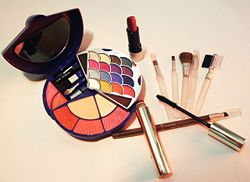
Assorted cosmetics and tools.
Cosmetics are substances used to enhance or protect the appearance or odor of the human body. They include skin-care creams, lotions, powders, perfumes, lipsticks, fingernail and toenail polishes, eye and facial makeup, permanent waves, hair colors, hair sprays and gels, deodorants, baby products, bath oils, bubble baths, bath salts, butters and many other types of products. Their use is widespread, especially among women in Western countries. A subset of cosmetics is called "make-up," which refers primarily to colored products intended to alter the user’s appearance.
The U.S. Food and Drug Administration (FDA), which regulates cosmetics in the United States,[1] defines cosmetics as products "intended to be applied to the human body for cleansing, beautifying, promoting attractiveness, or altering the appearance without affecting the body's structure or functions." This broad definition includes any material intended for use as a component of a cosmetic product. The FDA specifically excludes soap from this particular category.[2]
History
The history of cosmetics spans at least 6,000 years of human history, and almost every society on earth. In the Western world, the use of cosmetics became prominent in the Middle Ages, typically among members of the upper classes.
Cosmetic use was frowned upon at some points in history. For example, in the nineteenth century, make-up was used primarily by prostitutes, and Queen Victoria publicly declared makeup improper, vulgar, and acceptable for use by actors only.[3] Adolf Hitler told women that face painting was for clowns and not for the women of the Master Race.
By the middle of the twentieth century, cosmetics were in widespread use in nearly all societies around the world.
Ancient Egypt, Greece, and Rome
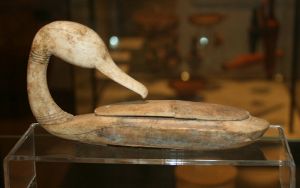
Egyptian cosmetics box from the Bronze Age.
The first archaeological evidence of cosmetics usage is found in Ancient Egypt around 4000 B.C.E. The Ancient Greeks and Romans also used cosmetics. The Romans and Ancient Egyptians used cosmetics containing mercury and white lead, unaware of their toxicity.[3]
Africa
The cosmetic uses of kohl and henna appear to have their roots in northern Africa.
The Middle East
Cosmetics were used in Persia and what is today the Middle East from ancient periods. The biblical book of Esther describes various beauty treatments. In addition, fragrances, particularly frankincense and myrrh are mentioned in the book of Exodus (Exodus 30:34) and the Gospel of Matthew (Matthew 2:11).
After Arab tribes converted to Islam and conquered various parts of the Middle East, cosmetics were restricted in some areas and were allowed only if they were to disguise the real look in order to mislead or cause uncontrolled desire.[citation needed] All branches of Islam set a number of rules of thumb relating to purity and cleanliness, whether in its physical or spiritual form.[citation needed] For some branches, the general rule is outlined by the Quran: “For Allah loves those who turn to Him constantly and He loves those who keep themselves pure and clean” (2:222). Muhammad also declared: "Allah is Beautiful and He loves beauty." [citation needed] On the other hand, some fundamentalist branches of Islam forbid the use of cosmetics.
An early cosmetologist was the physician Abu’al-Qassim al-Zahrawi, or Abulcassis (936-1013 C.E.), who wrote medical encyclopedia Al-Tasreef, in 30 volumes. Chapter 19 was devoted to cosmetics. As the treatise was translated into Latin, the cosmetic chapter was used in the West. Al-Zahrawi considered cosmetics a branch of medicine, which he called Medicine of Beauty (Adwiyat al-Zinah). He deals with perfumes, scented aromatics and incense. There were perfumed stocks rolled and pressed in special moulds, perhaps the earliest antecedents of present day lipsticks and solid deodorants. He used oily substances called Adhan for medication and beautification. [citation needed]
South Asia
Henna has been used in India since around the fourth or fifth centuries. [citation needed] It is used either as a hair dye, or in the art of mehndi, in which complex designs are painted on to the hands and feet, especially before a Hindu wedding.[citation needed] Henna is also used in some north African cultures. African henna designs tend to be bolder, and Indian designs more complex. [citation needed]
The use of kohl or kajal has a long history in Hindu culture.[citation needed] The use of traditional preparations of kohl on children and adults has been considered to have health benefits,[citation needed] though in the United States it has been linked to lead poisoning and is prohibited.[4]
China
Chinese people began to stain their fingernails with gum arabic, gelatin, beeswax and egg from around 3000 B.C.E. [citation needed] The colors used represented social class: Chou dynasty royals wore gold and silver; later royals wore black or red. The lower classes were forbidden to wear bright colors on their nails. [citation needed]
Japan
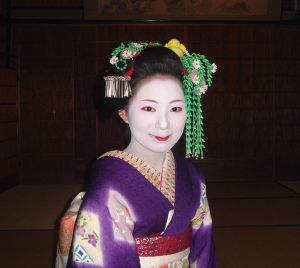
A
maiko in the Gion district of
Kyoto,
Japan, in full make-up. The style of the lipstick indicates that she is still new.
In Japan, geishas wore lipstick made of crushed safflower petals to paint the eyebrows and edges of the eyes as well as the lips. [citation needed] Sticks of bintsuke wax, a softer version of the sumo wrestlers' hair wax, were used by geisha as a makeup base. [citation needed] Rice powder colors the face and back; rouge contours the eye socket and defines the nose.[citation needed] Ohaguro (black paint) colours the teeth for the ceremony when maiko (apprentice geisha) graduate and become independent.[citation needed] The geisha would also sometimes use bird droppings to compile a lighter color.
Europe
In the Middle Ages, Renaissance and up until the Industrial Revolution, the lower classes had to work outside, in agricultural jobs. The typically light-colored European skin was darkened by exposure to the Sun. The higher class a person was, the more leisure time he or she had to spend indoors, which kept the skin pale. Thus, the highest classed of European society, able to spend all of their time protected from the Sun, frequently had the lightest-looking skin. As a result, European men and women often attempted to lighten their skin directly, or used white powder on their skin to look more aristocratic. [citation needed] A variety of products were used, including white lead paint which, as if the toxic lead wasn't bad enough, notoriously also contained arsenic.[citation needed] Queen Elizabeth I of England was one well-known user of white lead, with which she created a look known as "the Mask of Youth".[citation needed] Portraits of the queen by Nicholas Hilliard from later in her reign are illustrative of her influential style. [citation needed]
The Americas
Some Native American tribes painted their faces for ceremonial events or battle. [citation needed]
The twentieth century
During the early years of the twentieth century, make-up became fashionable in the United States of America and Europe owing to the influence of ballet and theatre stars such as Mathilde Kschessinska and Sarah Bernhardt. [citation needed] But the most influential new development of all was that of the movie industry in Hollywood. Among those who saw the opportunity for mass-market cosmetics were Max Factor, Sr., Elizabeth Arden, and Helena Rubinstein.[citation needed] Modern synthetic hair dye was invented in 1907 by Eugene Schueller, founder of L'Oréal. He also invented sunscreen in 1936.[citation needed]
After the First World War, the flapper look came into fashion for the first time, and with it came cosmetics: dark eyes, red lipstick, red nail polish, and the suntan, invented as a fashion statement by Coco Chanel. [citation needed] Previously, suntans had only been sported by agricultural workers, while fashionable women kept their skins as pale as possible. In the wake of Chanel's adoption of the suntan, dozens of new fake tan products were produced to help both men and women achieve the "sun-kissed" look. In Asia, skin whitening continued to represent the ideal of beauty, as it does to this day.
Cosmetic deodorant was invented in 1888, by an unknown inventor from Philadelphia,[citation needed] and was trademarked under the name Mumm. Roll-on deodorant was launched in 1952, and aerosol deodorant in 1965.[citation needed]
Industry Today
The manufacture of cosmetics is currently dominated by a small number of multinational corporations that originated in the early twentieth century, but the distribution and sale of cosmetics is spread among a wide range of different businesses.
The worldwide annual expenditures for cosmetics is estimated at U.S. $18 billion.[5] Of the major firms, the oldest and the largest is L'Oréal, which was founded by Eugene Schueller in 1909 as the French Harmless Hair Colouring Company (now owned by Liliane Bettencourt 27.5% and Nestlé 26.4%, with the remaining 46.1% are publicly traded). The market was developed in the USA during the 1910s by Elizabeth Arden, Helena Rubinstein, and Max Factor. These firms were joined by Revlon just before World War II and Estée Lauder just after.
Types
The various forms of makeup include:
- Lipstick, lip gloss, lip liner, lip plumper, lip balm, lip luster, lip conditioner and lip boosters.[1]
- Foundation, used to color the face and conceal flaws to produce an impression of health and youth. Usually a liquid, cream, powder or mousse.[1]
- Powder, or face illuminator used to set the foundation, giving a matte finish.
- Rouge, blush or blusher, cheek stain used to color the cheeks and emphasize the cheekbones. This comes in powder, cream and gel forms.[1]
- Bronzer, used to create a more tanned or sun-kissed look.[1]
- Mascara and lash extender, lash conditioner used to enhance the eyelashes. Can be of different colors and even waterproof. [1]
- Eye liner and eye shadow, eye shimmer and glitter eye pencils as well as different color pencils used to color and emphasize the eyelids (larger eyes are a sign of youth).[1]
- Eyebrow pencils, creams, waxes, gels and powders are used to fill in and define the brows.[1]
- Nail polish, used to color the fingernails and toenails.[1]
- Concealer, a type of thick opaque makeup used to cover pimples, various spots and inconsistencies in the skin.[1]
Also included in the general category of cosmetics are skin care products. These include creams and lotions to moisturize the face and body, sunscreens to protect the skin from damaging UV radiation, and treatment products to repair or hide skin imperfections (acne, wrinkles, dark circles under eyes, etc.).
Cosmetics can also be described by the form of the product, as well as the area for application.
Cosmetics can be liquid or cream emulsions; powders, both pressed and loose; dispersions; and anhydrous creams or sticks.
Special Effects
In addition to over-the-counter cosmetic products, recent years have seen an increasing market for prescription or surgical cosmetic procedures. These range from temporary enhancements, such as cosmetic colored contact lenses, to major cosmetic surgery.
Many techniques, such as microdermabrasion and chemical or physical peels, remove the oldest, top layers of skin cells. The younger layers of skin left behind appear more plump, youthful, and soft. Permanent application of pigments (tattooing) is also used cosmetically.
Ingredients
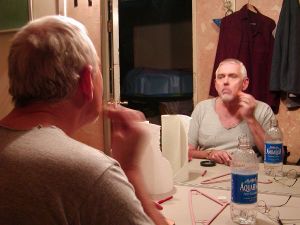
Broadway actor Jim Brochu applies make-up before the opening night of a play.
While there is assurance from the largest cosmetic companies that their various ingredients are safe, there is a growing preference for cosmetics that are without any "synthetic" ingredients, especially those derived from petroleum. Once a niche market, certified organic products are becoming more mainstream.
Ingredients' listings in cosmetics are highly regulated in many countries. The testing of cosmetic products on animals is a subject of some controversy. It is now illegal in the United Kingdom, the Netherlands, and Belgium, and a ban across the European Union is due to come into effect in 2009.
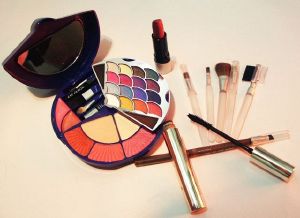
Assorted cosmetics and tools
Cosmetics ingredients come from a variety of sources but, unlike the ingredients of food, are often not considered by most consumers. Cosmetics often use vibrant colours that are derived from some unexpected sources, ranging from crushed insects to rust. Many new techniques have allowed manufacturers to synthesise such colours and the use of animals (or parts thereof) has been declining for many years and is now virtually eliminated, due in large part to the efforts of PETA. [citation needed]
Cosmetics in a variety of forms date back to early civilisations, with the need to improve ones personal appearance being an important factor in attracting a mate. Over the years the ingredients have changed dramatically as we discovered how to manufacture our own scents and cosmetic formulae. The realisation of the dangers of many common ingredients also greatly impacted the growing industry.[citation needed]
Ancient Egyptian aristocracy made use of minerals to provide colour and definition to their facial features. During the era of the Greek Empire it was common to use face paints, while the Romans indulged in baths containing oil-based perfume.[citation needed]
Common ingredients
Castor oil and its derivatives are found in many cosmetics as it is "non-comedogenic" (does not exacerbate or contribute to acne).[6]
Cerebrosides (cells from the nervous systems of cattle or swine) were once used in some high-end skin-care products to increase moisture retention and to create a smooth skin surface,[7] however the BSE controversy has put an end to this practice.[citation needed]
Visual effects
Strong red colors for eye products have been produced using the dye carmine, made from carminic acid extracted from the crushed bodies of the cochineal insect. [citation needed] Carmine was once the only bright red color permitted by the FDA for use around the eye.[citation needed]
Pearlescence (sometimes spelt "pearl essence") is a shine or gloss effect commonly used in a wide variety of cosmetic products. The most usual source of pearlescence is the natural mineral mica covered by a thin layer of titanium dioxide. This coating causes goniochromism – the colour appears through interference effects with the naturally translucent mica, and varying the thickness of the titanium dioxide changes the colour. Alternatives exist, including the suspension of tiny flakes of a suitable material within the product, often a wax such as glycol distearate. A shimmery substance found on fish scales, most usually obtained from herring and one of many by-products of commercial fish processing, can also be used for pearlescent effects, primarily in nail polish, but is now rarely used due to its high cost, bismuth oxychloride flakes being used as a substitute instead. [7]
Types of cosmetics
Facial cosmetics
The Romans and ancient Egyptians used cosmetics containing mercury.[citation needed]
Foundation
Women of Roman Britain used a foundation made from animal fat, starch and tin oxide.[8]
Lipstick
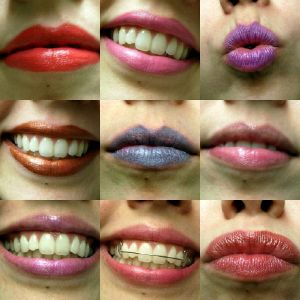
Lips with various shades of lipstick applied.
Lipstick is known to have been used around 5000 years ago in ancient Babylon, when semi-precious jewels were crushed and applied to the lips and occasionally around the eyes. Ancient Egyptians extracted purplish-red dye from fucus-algin, 0.01% iodine, and some bromine mannite, which resulted in serious illness. Cleopatra had her lipstick made from crushed carmine beetles, which gave a deep red pigment, and ants for a base.[9]
The red colour of modern lipstick can come from synthetically derived pure iron oxide (one of the components of rust), however most leading brands use the more economical synthetic colours. In the United States, every batch of synthetic dye and pigment must have a sample sent to the US FDA for testing and certification that the batch is pure and its contaminants are below the levels specified by law (Federal Food, Drug and Cosmetic Act CHAPTER VII—GENERAL AUTHORITY SUBCHAPTER B—COLORS
LISTING AND CERTIFICATION OF COLOR ADDITIVES FOR FOODS, DRUGS, AND COSMETICS [1]). Synthetic colours are listed in the ingredients as a code (eg: F &D red no 6) and may contain up to 10 parts per million of lead / 3 parts per million of arsenic. (Code of Federal Regulations, Title 21, Volume 1 -FOOD AND DRUGS, CHAPTER I—FOOD AND DRUG ADMINISTRATION, DEPARTMENT OF HEALTH AND HUMAN SERVICES, PART 74—LISTING OF COLOR ADDITIVES SUBJECT TO CERTIFICATION) There is some controversy over the presence of these trace ingredients, especially since makeup worn on the lips is not just absorbed through the skin, but also swallowed with drinking and eating. Since lowering these levels would make the production and sale of practically all lipstick illegal, and since the FDA has determined that the existing levels are safe, the cosmetic industry continues to produce and sell lipstick. (Color Additives: FDA's Regulatory Process and Historical Perspectives)[2]
Typically, the pigment is crushed very finely (7 to 10 micrometres) while being mixed with castor oil and is then mixed with a wax base to form a finished lipstick.
Lipsticks may be sheer or dense, matte or shiney. In their thinnest and most fluid consistency they are given their own category, lipgloss.
Perfume
Islamic cultures contributed significantly in the development of western perfumery in both perfecting the extraction of fragrances through steam distillation and introducing new, raw ingredients. Both of the raw ingredients and distillation technology significantly influenced western perfumery and scientific developments, particularly chemistry.[10]
As traders, Islamic cultures such as the Arabs and Persians had wider access to different spices, herbals, and other fragrance material. In addition to trading them, many of these exotic materials were cultivated by the Muslims such that they can be successfully grown outside of their native climates. Two examples of this include jasmine, which is native to South and Southeast Asia, and various citrus, which are native to East Asia. Both of these ingredients are still highly important in modern perfumery.[10]
The Crusaders brought alcohol-based perfumes back to Europe from the Middle East in the 13th Century.[11] The first modern perfume, made of scented oils blended in an alcohol solution, was made in 1370 at the command of Queen Elizabeth of Hungary and was known throughout Europe as Hungary Water. France quickly became the European centre of perfume and cosmetic manufacture, cultivating vast amounts of flowers for their essence. By the 18th century, aromatic plants were being specifically grown in the Grasse region of France to provide the growing perfume industry with raw materials.[citation needed]
Deodorants and antiperspirants
Perfume had been used to mask body odor for many hundreds of years, but in the late 19th century the ability to reduce such odor was developed. The original active ingredient of antiperspirants was aluminum chloride but complaints of skin irritation led to the increased use of aluminum chlorohydrate as an alternative.[11] Aluminum has been established as a neurotoxin and has been shown to adversely affect the blood-brain barrier, cause DNA damage, and have adverse epigenetic effects.[12][13] Research has shown that the aluminum salts used in antiperspirants have detrimental effects to a number of species such as non-human primates[14], mice[15], dogs[16] and others. An experiment with mice found that applying an aqueous solution of aluminum chloride to the skin resulted in "a significant increase in urine, serum, and whole brain aluminium."[17] Other experiments on pregnant mice showed transplacental passage of aluminum chloride.[15]
Regulation
Legislation varies from country to country but most countries have some sort of formal legislation that either restrict or prohibit certain ingredients or products. There are two main sources for cosmetics safety. The EU Cosmetics Directive 76/768/EEC and the Canadian Cosmetic Ingredient Hotlist.[3][4]
Cosmetic colorants are highly regulated. In the United States, the regulating body is the Food and Drug Administration. Each country or group of countries has their own regulatory agency that controls what can go into cosmetics. Many colorants in cosmetics are also used as food dyes.[citation needed]
Popularity and criticism
The popularity of cosmetics in the twentieth century has increased rapidly. Especially in the United States, cosmetics are being used by girls at a younger and younger age. Many companies have catered to this expanding market by introducing more flavored lipsticks and glosses, cosmetics packaged in glittery, sparkly packaging and marketing and advertising using young models. The social consequences of younger and younger beautification has had much attention in the media over the last few years.
Criticism of cosmetics has come from a variety of sources, including feminists, animal rights activists, books, and public interest groups. There is a growing awareness and preference for cosmetics that are without any toxic ingredients, especially those derived from petroleum, SLS, and parabens.[18]
Numerous published reports have raised concern over the safety of a few surfactants. SLS causes a number of skin issues including dermatitis.[19][20][21][22][23]
Parabens can cause skin irritation and contact dermatitis in individuals with paraben allergies, a small percentage of the general population.[24] Animal experiments have shown that parabens have a weak estrogenic activity, acting as xenoestrogens.[25]
Synthetic fragrances are widely used in consumers products. Studies concluded from patch testing, show synthetic fragrances are made of many allergic reaction ingredients.[26]
Potential dangers
The search for new ingredients and products often brings controversy, typically over ingredients whose functions are unproven or disputed.[citation needed]
There are few potential dangers regarding the use of cosmetics. One such danger is the use of old mascara. Some mascaras contain an ingredient that breaks down to produce formaldehyde. The formaldehyde prevents the growth of bacteria. Aged mascara, however, may no longer be producing formaldehyde, allowing bacteria to proliferate. For this reason, it is often recommended to replace a tube of mascara every few months .[27]
In one well-known case, Buddy Ebsen was originally cast as the "Tin Man" in the The Wizard of Oz. Aluminum dust was used to create a tin effect. As the result of an allergic reaction, he was hospitalized and Jack Haley replaced him. Aluminum dust was, instead, added to a paste.[citation needed]
See also
Notes
- ↑ 1.0 1.1 1.2 1.3 1.4 1.5 1.6 1.7 1.8 1.9 Reed, Sandra I. 2004. Cosmetics and Your Health. US Department of Health and Human Services. Retrieved September 11, 2007.
- ↑ Lewis, Carol. 2000. Clearing up Cosmetic Confusion. FDA. Retrieved September 11, 2007.
- ↑ 3.0 3.1 Johnson, Rita. 1999. What's that Stuff? Chemical & Engineering News. Retrieved September 11, 2007.
- ↑ FDA warning against the use of kohl and related products. Retrieved September 11, 2007.
- ↑ As Consumerism Spreads, Earth Suffers, Study Says. National Geographic. Retrieved September 11, 2007.
- ↑ ICOA Technical Bulletins - Effect on Skin. International Caster Oil Association. Retrieved September 11, 2007.
- ↑ 7.0 7.1 Adams, Cecil. 2000. Does lipstick contain fish scales?. Retrieved September 11, 2007.
- ↑ Roman cosmetic secrets revealed. BBC News. Retrieved September 11, 2007.
- ↑ Johnson, Rita. 1999. What's That Stuff? - Lipstick". Chemical and Engineering News. Retrieved September 11, 2007.
- ↑ 10.0 10.1 Levey, Martin. 1973. Early Arabic Pharmacology. Leiden, NL: E.J. Brill. ISBN 90-04-03796-9.
- ↑ 11.0 11.1 Brief History of Beauty and Hygiene Products. Ad*Access. Retrieved September 11, 2007.
- ↑ Aluminum-induced neurotoxicity: alterations in membrane function at the blood-brain barrier. NCBI PubMed. Retrieved September 11, 2007.
- ↑ A comet assay study reveals that aluminium induces DNA damage and inhibits the repair of radiation-induced lesions in human peripheral blood lymphocytes. NCBI PubMed. Retrieved September 11, 2007.
- ↑ Alterations in lipid composition and neuronal injury in primates following chronic aluminium exposure". NCBI PubMed. Retrieved September 11, 2007.
- ↑ 15.0 15.1 Transplacental passage of aluminium from pregnant mice to fetus organs after maternal transcutaneous exposure. NCBI PubMed. Retrieved September 11, 2007.
- ↑ Rapid Communications: Antiperspirant Induced DNA Damage in Canine Cells by Comet Assay. NCBI PubMed. Retrieved September 11, 2007.
- ↑ Bioaccumulation of water-soluble aluminium chloride in the hippocampus after transdermal uptake in mice. NCBI PubMed. Retrieved September 11, 2007.
- ↑ Signers of the Compact for Safe Cosmetics. Campaign for Safe Cosmetics. Retrieved September 11, 2007.
- ↑ Agner T. 1991. Susceptibility of atopic dermatitis patients to irritant dermatitis caused by sodium lauryl sulphate. Acta Derm Venereol. 71:4:296-300.
- ↑ Nassif, A., S. C. Chan, F. J. Storrs and J. M. Hanifin. 1994. Abstract Abstract: Abnormal skin irritancy in atopic dermatitis and in atopy without dermatitis. Arch Dermatol. 130:11:1402. Retrieved September 11, 2007.
- ↑ Marrakchi, S., H.I. Maibach. 2006. Sodium lauryl sulfate-induced irritation in the human face: regional and age-related differences. Skin Pharmacol Physiol. 19:3:177-80.
- ↑ CIR publication. 1983. Final Report on the Safety Assessment of Sodium Lauryl Sulfate and Ammonium Lauryl Sulfate. Journal of the American College of Toxicology. 2:7:127-181.
- ↑ Loffler H, Effendy I. 1999. Skin susceptibility of atopic individuals. Department of Dermatology, University of Marburg, Germany. Contact Dermatitis. 40:5:239-42.
- ↑ Nagel J..E, J.T. Fuscaldo, P. Fireman. 1977. Paraben allergy. JAMA. 237:15:1594-5.
- ↑ Byford J.R., L.E. Shaw, M.G. Drew, G.S. Pope, M.J. Sauer, P.D. Darbre. 2002. Oestrogenic activity of parabens in MCF7 human breast cancer cells. J Steroid Biochem Mol Biol. 80:1:49-60.
- ↑ Patch testing with fragrances: results of a multicenter study of the European Environmental and Contact Dermatitis Research Group with 48 frequently used constituents of perfumes. Contact Dermatitis. Retrieved September 11, 2007.
- ↑ "FDA/CFSCAN Cosmetics — Shelf Life - Expiration Date". Retrieved September 11, 2007.
References
ISBN links support NWE through referral fees
- Winter, Ruth. 2005. A Consumer's Dictionary of Cosmetic Ingredients: Complete Information About the Harmful and Desirable Ingredients in Cosmetics. New York, NY: Three Rivers Press (Random House). ISBN 1400052335.
- Michalun, Natalia and Varinia Michalun. 2000. Skin Care and Cosmetic Ingredients Dictionary. Clifton Park, NY: Milady (Delmar Cengage Learning). ISBN 1562536605.
- Byers, Dorie. 2001. Natural Beauty Basics : Create Your Own Cosmetics and Body Care Products. Ridgefield CT: Vital Health Publishing. ISBN 1890612197.
External links
Credits
New World Encyclopedia writers and editors rewrote and completed the Wikipedia article
in accordance with New World Encyclopedia standards. This article abides by terms of the Creative Commons CC-by-sa 3.0 License (CC-by-sa), which may be used and disseminated with proper attribution. Credit is due under the terms of this license that can reference both the New World Encyclopedia contributors and the selfless volunteer contributors of the Wikimedia Foundation. To cite this article click here for a list of acceptable citing formats.The history of earlier contributions by wikipedians is accessible to researchers here:
The history of this article since it was imported to New World Encyclopedia:
Note: Some restrictions may apply to use of individual images which are separately licensed.
